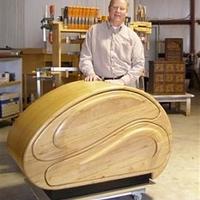
David L. Whitehurst
in over 11 years
Apprentice Shop #1: Sharing My Plans To Start an Apprentice Shop
This is
part 1
in a
1 part
series:
Apprentice Shop
-
Sharing My Plans To Start an Apprentice Shop
- Sharing My Plans To Start an Apprentice Shop
Back in the winter of 2013, my dad told me to come get his shop tools. He’s retired once and then started back, and now he’s fully retired. Anyhow, I went to Virginia and brought home a table saw, a radial-arm, a band saw, a drill-press, and a contractors chop saw. I was really not that excited because I know my dad as a craftsman. He’s designed and built sport fishing boats in the 50-60 foot range. He’s built and sold a $55K high-performance boat for sport fishing that was 25 foot long that held 125 gallons of fuel. He’s built all kinds of things for land and water. And, everyone that knows him just appreciates his talent.
It was sad for me to bring his tools home because this marked an end in his work. I was thankful to get the tools on one hand and heartbroken that he would create no more. Well, now I tell him everything I do when it comes to my renewed interest in woodworking.
I’ve learned a lot of things I didn’t know in a very short period. I’ve learned simple things that I should have know well before I was 51 years of age. I grew up with pine and never put a saw on any other board except I think the corner of the coffee table was maple that I cut when I was real little. Just getting wood from somewhere other than the hardware store may seem daunting. Getting wood from a lumber mill to look like the grade-A select stuff at the hardware store is quite a chore. I’ve learned that I can save you tons of money in sandpaper. If you have a belt sander, throw it away. You don’t need it. No, better yet, blow it off with the air compressor and put it away in long term storage. You can give it to your children and let them learn their own lessons.
I spent 15 years, in 8 different positions at Newport News Shipbuilding in the Submarine Engineering program. I know how to make things and I’m at a point in my life where I want to show others how to use their talents with their hands. I have 2 sons that are not “college material”. I actually hate that stereotype because I don’t think the public school system should push every child to go to college. Is it a coincidence that most of the tradesmen, craftsmen, painters, electricians, plumbers, furniture-makers were once labeled the “bad kids”? I strongly believe that these kids need guidance in 1) work ethic 2) craftsmanship and 3) service philosophy.
I want to establish a business of making furniture designs of my own, using apprentices to do this, and/or assisting others to get their own business going. I’ve run my own software consulting business in the past and I currently manage software development in the financial and insurance verticals.
If anyone is interested in helping the evolution of this idea of an Apprentice School for Woodworking let me know. I think it can be another option for young people other than college. I’ve worked as a computer scientist without a degree for 29 years. I left Newport News Shipbuilding after 2 consecutive yearly promotions over others with bachelors and master degrees because my wife was dying of cancer and I needed more income. Not everyone needs to go to college or should. Education is extremely important but with the caveat that not every child should be forced to do something that may be very difficult for them.
Stay tuned. I’m going to share some simple but really important lessons soon.
David L. Whitehurst
11 Comments
That sounds both exciting and a bit daunting. I have absolutely no experience in this but …Buy plenty of insurance :)
Some of the cleverest people I’ve met were not university grads. Tradespeople constantly solve problems and find creative ways to do things. Plenty of Uni grads are clever and creative, too…it’s just not the only way to measure competence and skill.
I was lucky enough to find a mentor when I first came out of high school…probably saved me from a life of labouring. Best of luck.
-- Alec (Friends call me Wolf, no idea why)
David,
I like your idea and wish you the best of luck. I owned and operated a small custom woodworking shop in Creedmoor, NC ( 20 miles north of Raleigh) for 20 years before relocating to Myrtle Beach, SC.
The Triangle area was good to me and my business. I’m sure it won’t be hard to find interested canidates for your program. Teaching them woodworking will be the easy part, teaching them how to run a successful woodworking business will be the challenge.
I was lucky to have gained years of experience in marketing and sales before I started my own business and it didn’t take me long to realize that those two elements would be just as important to having a successful woodworking business as being good at woodworking itself.
I’m retired and living in Florida now, but if there is anyway I can help you please let me know. I would love to be able to “pay forward” some of my experiences and knowledge.
John @The Hufford Furniture Group
" I strongly believe that these kids need guidance in 1) work ethic 2) craftsmanship and 3) service philosophy"
I agree with your statement. I like your attitude and what plan to do.
While in college I agree to tutor “troubled” kids that where failing behind in school because there was no guidance. I tutor in math, and sciences mainly. most of them made to college thanks to the dedication of a widow who transformed her house in an after school homework help place.
I do believe in college education. Time are changing. now a scanner go through your resume looking for key words before you get an interview. Sure there are plenty of people getting good jobs without a 4 year degree but the salary difference is evident in many cases.
For those kids who can’t make it to college for various reason, money most of the time, an apprentice program is great and I admire you for wanting to do that.
my dad too is no longer able to go down to his shop. Last summer he wanted to give me his tools. That was the most difficult thing I faced. I literarily choked. Of course I accepted, those are treasures. I left them in my parents house until I have the courage to move them.
I wish the best and hope you succeed in this journey.
Abbas, Castro Valley, CA
Huff, I’m in Fuquay Varina, south of Raleigh. I work in Morrisville and sometimes home on the computer. I found a resource for lumber in Rolesville. His name is Jack. I want to do what you did and then I really want to leave behind a legacy, a legacy where my father had no concern. I am the 13th generation of William Richard Whitehurst who came to Virginia Beach in 1622. I have two sons that have done terrible in school, are lazy, and they don’t follow my lead. I don’t know why but I’m determined that I’m going to do what I love. I’ve been doing commissions for old school friends, but I didn’t price things right. If you have any marketing suggestions for picking up commissions, please by all means let me know. Right now I’m using sassafras at $2.50 bd-ft to build a toolbox for all my woodworking hand-tools. I want to bring in the commissions and then help a few local young folks find this joy too. For now I want to start small, but I am very familiar with the Apprentice School at Newport News Shipbuilding and that’s my dream to leave behind for Woodworkers. I just don’t like that particle board stuff from Walmart. :-)
David L. Whitehurst
Huff, I’m reading your blog post and YES, I’m not pricing correctly. I wanted to make the little shaker table first as a prototype in pine and I did. It was gorgeous! And, I had all these ends of 2×4′s that I used to make a Paul Sellers bench. So material was no issue. And, I was learning. Then I got a request to do one for a friend that I’ve known since elementary school and rode my bus. I convinced her to do one in walnut. I quoted her $100 + cost of the walnut (estimated $30). I got $45 in walnut and I’ve since delivered the table to Virginia and she wants a second. I told her $100 + material (we’ll do the $30 again). So $260 for 2 beautiful walnut tables. I did the cherry one using wood from a friend’s family’s farm supposedly the tree was there in late 1600’s. It was full of worm holes but still turned out beautiful. It was $100 and she gave me the wood. I think I should have charged about $450 a piece for the tables. Look at my creation and tell me what you think.
David L. Whitehurst
David,
I’m very familiar with Fuquay Varina ( I have a few old customers in the area).
The Cherry table is beautiful and I really enjoyed your write-up on the build. As far as pricing goes, have you tracked your time on any of the tables? Since you’ve built three so far, I’m sure your time has improved.
As you develop your business, you will really want to track your time for each phase of a build, that way you will be able to estimate your time more accurately on future projects. Another words, once you know how long it takes you to hand dovetail a drawer, then it doesn’t matter if the project has one drawer or 10 drawers, you should be able to get a good feel on how long that phase of the build will take.
I used to keep a time card on every build I did for the first couple years I was in business. It took extra time to keep track of every minute of the build, but it was a great “eye opener” as to where I was spending a lot of my time and how I could improve.
Pricing our woodworking is one of the hardest things to get comfortable with and even after years of doing it, you will still have times you want to doubt your prices, but once you establish a fact based way of pricing your work ,(making sure you are covering all your cost such as overhead, materials, labor and profit) you will feel confident is quoting a price that will allow you to charge a fair price for your work.
That doesn’t mean it will be the lowest price or a price a customer may be willing to pay, but it will be a price that you will have to charge if you want to stay in business.
Let me know if I can answer any questions and feel free to drop me an e-mail.
huffordfurnituregroup@yahoo.com
John @The Hufford Furniture Group
If I can add to Huff’s comments……..
There are a lot of steps to the process you’re considering and it may well seem overwhelming at times, but it is a worthy journey. We have to be willing to give back to the community at large and the woodworking community specifically in order for our craft to continue. Over the years I’ve trained several guys, at least 2 of which now have very successful woodworking shops. While it was their talent that kept them going, it was fun to be a part of their growth.
Do your homework and due diligence. Things like general liability business insurance, healthcare (obamacare) and worker’s comp requirements, local permitting and licensing requirements, rent, and utilities all factor into your overhead. Administrative costs, such as accounting services, billing, and advertising, are involved as well. And then there is the cost of equipment; buying, replacing, and maintaining.
All those factor into your pricing before you consider the price of materials for the project. I have a shop rate that I use when determining the cost of a project. Generally speaking, I estimate the time needed to complete each step of the project, add a percentage for unforeseen delays, multiply the number of hours by my shop rate, and add the material costs. That becomes my price, and it is firm. If the customer wants to “negotiate” the price, I will remove features from the bid, but not price itself. You have to be confident in your pricing based on your abilities and know what your work is worth, otherwise you will end up losing money.
Artisan Woodworks of Texas- www.awwtx.com
If the customer wants to “negotiate” the price, I will remove features from the bid, but not price itself. You have to be confident in your pricing based on your abilities and know what your work is worth, otherwise you will end up losing money.
Bill makes a great point! Too many times, if a woodworkers is questioned about their price and the customer wants to “negotiate”, they (the woodworker) automatically feels they are too high priced and lowers the price.
I did a blog series on Lumber Jocks about pricing your woodworking and it is based on having a shop labor rate like Bill mentions to make sure you are covering “all” cost of building a project.
If your pricing is based on facts, then you should have the confidence to quote a customer knowing that is the best price you can offer other then removing features and/or downsizing the project. Just lowering the price, tells the customer that you weren’t confident in your pricing or your work from the very beginning and that will never give the customer much confidence in you.
John @The Hufford Furniture Group
Okay, wow!
Where would I start? This is why my father wasn’t successful in his own business. My mom kept telling him that even his friends were customers.
So should I look for your blog post Huff? I want to determine all this now before I do the next piece for anyone. I don’t know where to start. E.g. my power tools were given to me and how would I figure in the cost of replacement? What a loan would cost monthly to replace them all? It killed me with my walnut table because, I didn’t have a resource for secondary wood and the popular was $35 at Home Depot. I think a can of Zinnser and paste wax was over $20. How do I determine my electric? My wife said she hasn’t really seen too much of a change, but there’s a change I know. I’ve bought old Disston saws, sharpened them. De-rusted Stanley planes and refurbed. I’ve made a few tools, jigs, etc. I’ve bought books, … you name it I’ve spent it.
I’ve paid close attention to skills and what takes time. I don’t have a planer and while I love hand planing, the re-sawn, glued wide boards take time to prepare for use. I try to do everything like what I call “hustle work”. E.g. If I set a fence, router table, point fence, angle, etc. I do everything in hustle mode. Whistle while you work and get it done. And, the planing and the dovetailing take time. You have to slow down.
If there is a book, web site, comments, whatever in establishing this shop price, point me. I’ll be your apprentice from afar. I also would love an explanation using that shop rate on how one would price e.g. a group of cabinets for someone’s kitchen.
David L. Whitehurst
David, If I can help give me a call. My contact information is on our website www.awwtx.com
Bill
Artisan Woodworks of Texas- www.awwtx.com
David,
Here is a link to the blog series I did on pricing. Hope it will give you some ideas.
http://lumberjocks.com/huff/blog/series/6413
If you have any questions or would like some help just drop me a line. huffordfurnituregroup@yahoo.com
John @The Hufford Furniture Group












